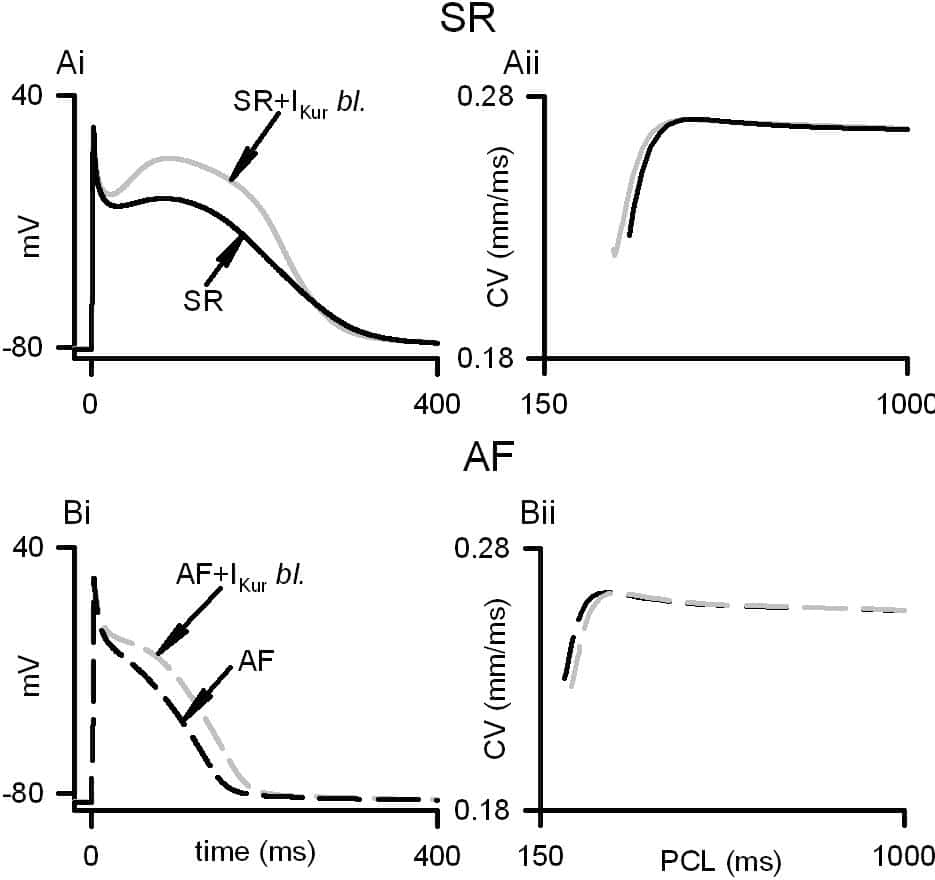The anti-arrythmogenic effects of pharmacological blocking of the atrial specific ultra rapid potassium current (IKur) under atrial fibrillation (AF) conditions were studied in silico in this study. Reduction of IKur by 80% based on experimental data [1] was incorporated into a computer model of human atrial action potential (AP) developed by Courtemanche et al. [2] under normal (i.e. sinus rythm, SR) and AF conditions, that considered the AF-induced ion channel remodelling in human atrial cells [3, 4]. The effects of IKur block on atrial AP were quantified by changes in the characteristics of APs that include the AP duration (APD), APD restitution (APDr), effective refractory period (ERP) and ERP restitution (ERPr). Using 1D strand models, intra-atrial conduction velocity (CV), CV restitution (CVr) and temporal vulnerability window (VW) of tissue to genesis of uni-directional conduction block by an extra-stimulus were computed [4]. Re-entrant wave behaviour in idealised 2D sheets and realistic 3D anatomical model was simulated [5]. Under SR conditions, IKur block prolonged the AP plateau phase, but marginally shortened APD (by 4.8%) (Figure 1, Ai) and ERP (by 2.5%). In the AF-remodelled tissue, IKur block increased APD (by 16.2%) (Figure 1, Bi) and ERP (by 15.4%). IKur block did not affect CV at low pacing rates (0.27 mm/ms under SR, 0.25 mm/ms under AF), but modulated tissue’s ability to support excitation wave conduction at high pacing rate (Figure 1, Aii and Bii). The cut off pacing cycle length (PCL) (i.e. the maximal PCL at which the tissue can sustain propagation) was reduced from 320 ms to 313 ms in the normal tissue, but was increased from 198 ms to 217 ms in the AF-remodelled tissue. IKur block augmented tissue’s VW by 7.5% in the normal tissue, but reduced it by 19.2% in the AF-remodelled tissue. In 2D idealised sheets and in the 3D simulations, blocking IKur did not affect re-entrant wave or scroll wave dynamics. Collectively, our simulation data show the pro-arrhythmic effects of block IKur under SR conditions, but anti-arrhythmic effects in the AF-remodelled case. Since IKur is atrial specific, it is an attractive potential target for AF drug therapy treatment.
University of Manchester (2010) Proc Physiol Soc 19, PC14
Poster Communications: Anti-arrythmogenic Effects of Atrial Specific IKur Block: A Modelling Study
P. Law1, S. Kharche1, H. Zhang1
1. School of Physics and Astronomy, University of Manchester, Manchester, United Kingdom.
View other abstracts by:
Figure 1. Effects of IKur block on SR cell APs (Ai) and 1D strand CVr (Aii) (solid line: Control; gray line: IKur block). Effects of IKur block in AF-remodelled cell APs (Bi) and 1D strand CVr (Bii) (solid line: Control; gray line: IKur block).
Where applicable, experiments conform with Society ethical requirements.

